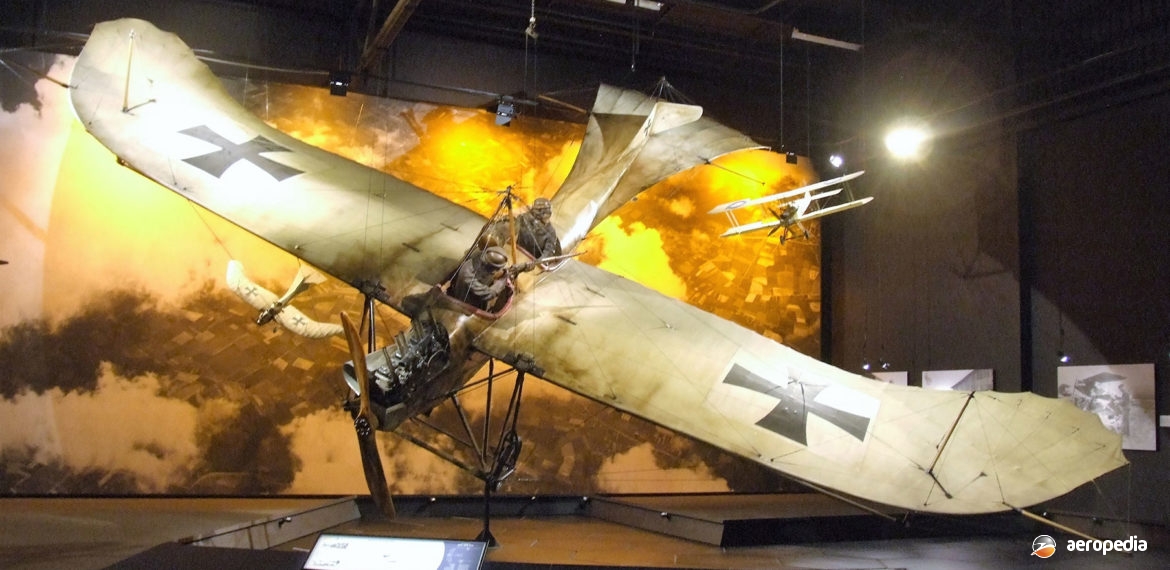Photograph:
Etrich Taube on display at the Omaka Heritage Centre, NZ in 2011 (David C Eyre)
Country of origin:
Austria
Description:
Single or two-seat reconnaissance aircraft
Power Plant:
One 75 kw (100 hp) Mercedes E4F six-cylinder in-line liquid-cooled engine
Specifications:
- Wingspan: 14.3 m (45 ft 8 in)
- Length: 9.9 m (35 ft 5 in)
- Height: 3.2 m (10 ft 5 in)
- Wing area: 32.5 m² (280 sq ft)
- Max speed: 100 km/h (62 mph)
- Max cruising speed: 90 km/h (56 mph)
- Service ceiling: 2,000 m (10,000 ft)
- Range: 140 km (87 miles)
- Wing loading: 31 kg/m² (6.36 lb/sq ft)
- Empty weight: 600 kg (1,323 lb)
- Disposable load: 260 kg (573 lb)
- Loaded weight: 860 kg (1,896 lb)
Armament:
Light bombs; revolver or rifle operated by pilot
History:
The Taube (German for Dove) was designed and built by Igo Etrich in Austria in 1908 and became well liked for its performance and handling. Rights to the design were then obtained by the German Government and Rumpler Luftfahrzeugbau GmbH of Berlin received a contract to build 20 examples. These were so successful the type became the standard design issued to units of the German Army for reconnaissance work prior to World War I and, in order to meet demand, at least 14 other manufacturing plants were contracted to place the type in production. Eventually there was a falling out between Rumpler and Etrich and Germany refused to pay further licence fees.
Although named the Taube the aircraft was not modelled after a bird but after the Zanonia macrocarpa seed which glided to the ground in a slow spin induced by a single wing. A Taube was the first German aircraft to fly over Paris; and one was flown by Messrs A Friedrich and Dr H Elias from Berlin to Villacoublay in Paris on 7 September 1913. On 13 September it was flown by Friedrich and Igo Etrich to London, Great Britain and later in the month returned to Berlin via Calais, Antwerp, Nijmegen and Hanover, arriving on 20 September 1913.
Thus the design has always been known as the Taube, but has also been known as the Etrich Taube after the designer, Rumpler Taube, etc. Manufacturers involved in production included Albatros Flugzeugrwerke, Aviatik, DFW, this model having a steel airframe; Gotha, Harlandpfeil, Halberstadt, Jeannin, also with a steel airframe; Kondor, Leudemann, Lilbeck Travemunde, Reise-und-Industrieflug, Roland, Rumpler, etc.
Largest producer of the type was Rumpler and it seems there were variations in dimensions and power plant fitted from one manufacturer to another. The metal-framed aircraft were known as the Stahltauben. A variety of engines was installed ranging from 52 kw (70 hp) to 90 kw (120 hp), including units from Mercedes, Argus, Daimler and Austro-Daimler. One variant known as the Albatros Doppeltaube was a biplane model built by Albatros Flugzeugwerke.
Control was by wing warping and using the elevators at the rear of the tail. It has on occasion been known as the world’s very first stealth plane due to the translucent wings, the wings being finished with clear dope on the fabric covered wings, making them difficult to see. It was noted for its ability to reach high altitudes. In about 1914 one reached a height of almost 6,096 m (20,000 ft).
The Taube first saw combat in Libya in 1911 when an Italian pilot used pistols and 2 kg (4.4 lb) bombs. It was also used to drop bombs in the Balkans in 1911. On 13 August 1918 Lt Von Hidde dropped by hand two 2 kg (4.4 lb) bombs on a suburb of Paris; and at about the same time German ace Lt Max Immelmann dropped a note on Paris calling on the population of the city to surrender to German forces.
No original Taube is known to survive but a few replicas have been completed, one airworthy example being imported to the collection of World War I period aircraft on display at the Omaka Heritage Centre, Blenheim, NZ in early 2006. This replica has been powered by a LIM in-line engine. This aircraft was built in Germany and was airworthy, and was displayed flying at an aviation event in Berlin in 2004.
One replica overseas has been fitted with a 149 kw (200 hp) Ranger six-cylinder in-line liquid-cooled engine and is reported to have a maximum speed of 97 km/h (60 mph).

